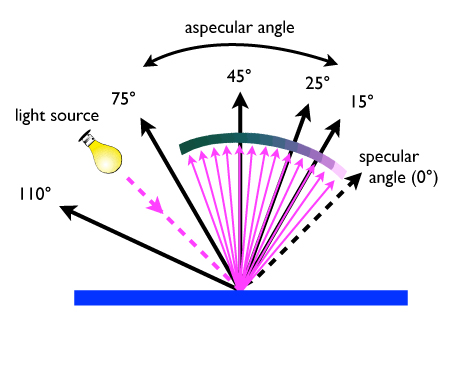Measurement Geometry Basics: Gonioapparent Materials
| Gonio-apparent materials are those that reflect color differently depending on the incident/detection geometry. These present special challenges to conventional bidirectional and hemispherical geometries. | |
Schematic gonio measurement showing angular terminology  | |
| The diagram above shows the relationship of the incident light, the specular angle and various aspecular angles. Aspecular can be a confusing term. It is measured relative to the specular angle, so 0° aspecular is equal and opposite the incident light. A rendering of the measured color at a range of aspecular angles is shown below. The range of colors produced by this material is large. If you used a conventional single-geometry spectrophotometer you would only get a single number. Somewhere along this range, but clearly there is no single measurement that can quantify the color of this material. | |
 Chromaflair is trademarked JDS Uniphase. It is shown here only as a representative gonioapparent material. Finally here is a diagram of a typical 2D gonio measurement system. In this schematic, the light source is fixed, the sample rotates (varying incident angle) and the detector rotates (varying detection angle). Note that it is critical that the centers of rotation of the sample and detector are coincident, and precisely on the surface of the sample. | |
 | |
| Other geometry tutorials: Bidirectional | Hemispherical | Other (gonio) |